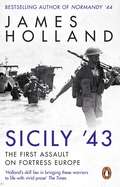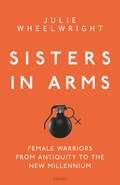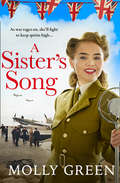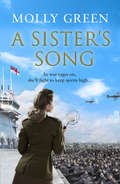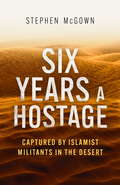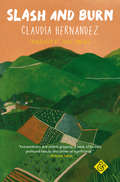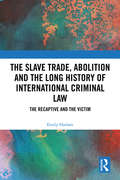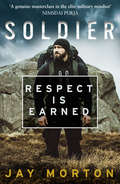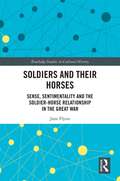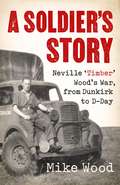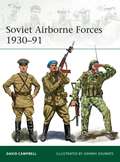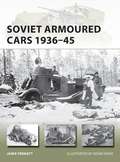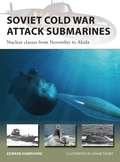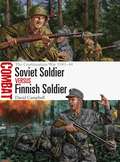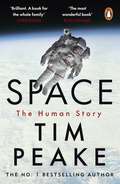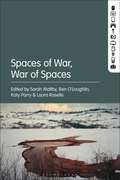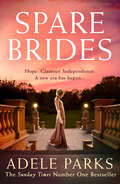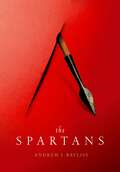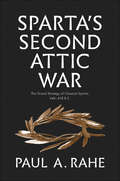- Table View
- List View
Sicily '43: A Times Book of the Year
by James Holland'James Holland is the best of the new generation of WW2 historians.' Sebastian Faulks'Holland's skill lies in bringing these warriors to life with vivid prose.' The TimesShortlisted for the 2021 British Army Military Book of the Year_________________________________________________This is the story of the biggest seaborne landing in history.Codenamed Operation HUSKY, the assault on Sicily on 10 July 1943 remains the largest amphibious invasion ever mounted. That day, over 160,000 Allied troops were dropped from the sky or came ashore to begin the fight for Europe.The subsequent thirty-eight-day Battle for Sicily was one of the most dramatic of the entire war, involving daring raids by special forces, deals with the Mafia, attacks across mosquito-infested plains and perilous assaults up almost sheer faces of rock and scree.Made worse by virulent disease and extreme heat, the Allies also had to fight their way across an island of unforgiving landscape and limited infrastructure against a German foe who would not give up.Victory would signal the beginning of the end of the War in the West. From here on, the noose began to tighten around the neck of Nazi Germany. The coalition between the United States and Britain finally came of age. And it was a crucial dry run for Operation OVERLORD, the invasion of Normandy on D-Day a year later.
Sisters in Arms: Female warriors from antiquity to the new millennium
by Julie Wheelwright'A long overdue assertion on the role of women on the battlefield. This book is going straight on my daughter's bookshelf.'Dan Snow, historian, TV presenter and broadcaster 'Sisters in Arms shows the many faces of women in combat – from the myths of the ancient world to the headline-grabbing conflicts of today – with a scrupulous attention to their different contexts, but a common compassion for their struggles and achievements.'Boyd Tonkin, journalist and author 'Wheelwright not only uncovers neglected female warriors, but she brings their temperaments, talents, fancies, and foibles to life.'Professor Joanna Bourke, Birkbeck, University of LondonSisters in Arms charts the evolution of women in combat, from the Scythian warriors who inspired the Amazonian myth, to the passing soldiers and sailors of the eighteenth century, and on to the re-emergence of women as official members of the armed forces in the twentieth century. Author Julie Wheelwright traces our fascination with these forgotten heroines, using their own words, including official documents, diaries, letters and memoirs, to bring their experiences vividly to life. She examines their contemporary legacy and the current role of women in the armed forces, while calling into question the enduring relationship between masculinity and combat.
Six Years a Hostage: Captured by Islamist Militants in the Desert
by Stephen McGownStephen McGown was en route from London to South Africa, on a once-in-a-lifetime trip by motorbike, returning home to Johannesburg. He had reached Timbuktu, in Mali, when he was captured, along with a Dutch and a Swedish national, by Al Qaeda Islamist militants. Steve was taken because he held a British passport. He was subsequently held hostage at various camps in the Sahara Desert in the north-west of Africa for nearly six years before eventually being released.Life as Steve had known it changed in that instant that he was taken at gunpoint. He had nothing to bargain with, and everything to lose. For the next six years, he reluctantly engaged in what he came to call the greatest chess game of his life. Thousands of kilometres to the south, in Johannesburg, the shock of Stephen's capture struck the McGown family and his wife, Cath, with whom he had, until recently, been living in London. They immediately began efforts to secure Steve's release, through diplomatic channels and in every other way they felt might have a chance of seeing Stephen freed. But as the months of captivity became years, Steve was compelled to go to extraordinary lengths to survive. Making it back home alive became his sole aim. To accomplish this, he realised that he would have to do everything he could to raise his status in the eyes of his captors. To this end, he taught himself Arabic and French, and also converted to Islam, accepting a new name, Lot. To this day, Steve retains the unenviable record of being the longest-held, surviving prisoner of Al Qaeda. While he was undoubtedly always Al Qaeda's captive, through the long years he spent in intimate proximity to his captors, Steve got to see the Islamist militants as few other Westerners have ever seen them. Six Years a Hostage is not only a remarkable story of mental strength, physical endurance and the resilience of the human spirit, but also, significantly, a unique and nuanced perspective onone of the world's most feared terrorist groups. Steve did not merely survive his terrible ordeal; he emerged from the desert a changed - stronger, more positive - human being. This is Stephen McGown's remarkable story, as told to Tudor Caradoc-Davies, a freelance writer, editor and author based in Cape Town, South Africa. After seven years spent working for glossy magazines such as Men's Health, GQ, Best Life and Women's Health, he now contributes to a range of publications. He also writes for the (South African) Sunday Times, and Red Bulletin.
Slash and Burn
by Claudia HernándezThrough war and its aftermaths, a woman fights to keep her daughters safe. As a girl she sees her village sacked and her beloved father and brothers flee. Her life in danger, she joins the rebellion in the hills, where her comrades force her to give up the baby she conceives. Years later, having outlived countless men, she leaves to find her lost daughter, travelling across the Atlantic with meagre resources. She returns to a community riven with distrust, fear and hypocrisy in the wake the revolution. Hernandez’ narrators have the level gaze of ordinary women reckoning with extraordinary hardship. Denouncing the ruthless machismo of combat with quiet intelligence, Slash and Burn creates a suspenseful, slow-burning revelation of rural life in the aftermath of political trauma.
The Slave Trade, Abolition and the Long History of International Criminal Law: The Recaptive and the Victim
by Emily HaslamModern international criminal law typically traces its origins to the twentieth-century Nuremberg and Tokyo trials, excluding the slave trade and abolition. Yet, as this book shows, the slave trade and abolition resound in international criminal law in multiple ways. Its central focus lies in a close examination of the often-controversial litigation, in the first part of the nineteenth century, arising from British efforts to capture slave ships, much of it before Mixed Commissions. With archival-based research into this litigation, it explores the legal construction of so-called ‘recaptives’ (slaves found on board captured slave ships). The book argues that, notwithstanding its promise of freedom, the law actually constructed recaptives restrictively. In particular, it focused on questions of intervention rather than recaptives’ rights. At the same time it shows how a critical reading of the archive reveals that recaptives contributed to litigation in important, but hitherto largely unrecognized, ways. The book is, however, not simply a contribution to the history of international law. Efforts to deliver justice through international criminal law continue to face considerable challenges and raise testing questions about the construction – and alternative construction – of victims. By inscribing the recaptive in international criminal legal history, the book offers an original contribution to these contentious issues and a reflection on critical international criminal legal history writing and its accompanying methodological and political choices.
The Slave Trade, Abolition and the Long History of International Criminal Law: The Recaptive and the Victim
by Emily HaslamModern international criminal law typically traces its origins to the twentieth-century Nuremberg and Tokyo trials, excluding the slave trade and abolition. Yet, as this book shows, the slave trade and abolition resound in international criminal law in multiple ways. Its central focus lies in a close examination of the often-controversial litigation, in the first part of the nineteenth century, arising from British efforts to capture slave ships, much of it before Mixed Commissions. With archival-based research into this litigation, it explores the legal construction of so-called ‘recaptives’ (slaves found on board captured slave ships). The book argues that, notwithstanding its promise of freedom, the law actually constructed recaptives restrictively. In particular, it focused on questions of intervention rather than recaptives’ rights. At the same time it shows how a critical reading of the archive reveals that recaptives contributed to litigation in important, but hitherto largely unrecognized, ways. The book is, however, not simply a contribution to the history of international law. Efforts to deliver justice through international criminal law continue to face considerable challenges and raise testing questions about the construction – and alternative construction – of victims. By inscribing the recaptive in international criminal legal history, the book offers an original contribution to these contentious issues and a reflection on critical international criminal legal history writing and its accompanying methodological and political choices.
The Smuggler’s Wife (The\smuggler's Daughters Ser. #3)
by Evie GraceThe brand new novel from bestselling author Evie Grace, set amongst the Napoleonic Wars in the 1800s. Perfect for fans of Dilly Court and Poldark. _______________________KENT 1815 Her heart led her to him, but will loyalty be enough to make her stay . . .When the beautiful but naïve Grace Lennicker falls for Isaiah Feasey, son of a rival smuggling family and owner of a local tavern, her sisters try to intervene. But as tensions grow, there is another suitor also hoping to win her hand in marriage, the dashing and more favourable Albert Enderby, a young lieutenant in the Revenue.Grace is unwittingly drawn back into the world of smuggling that her sisters fought hard to leave behind, and as violence erupts, she finds herself unable to stand by, knowing the rival gangs will kill anyone who stands in their way. When her husband becomes involved, Grace is forced to make a difficult decision - turn him in and risk her life, or stay loyal and risk the lives of those she loves . . .Praise for Evie Grace'Intriguing' Val Wood'A charming historical read that hits all the right notes' Woman's Weekly'Heart-tugging saga of which Catherine Cookson would've approved' Peterborough Evening Telegraph
Soldier: Respect Is Earned
by Jay MortonWith four years in the Parachute Regiment, ten years in the SAS and two Everest summits to his name, no one is better equipped than Jay Morton to reveal what it takes to become the best of the best.
Soldiers and Their Horses: Sense, Sentimentality and the Soldier-Horse Relationship in The Great War (Routledge Studies in Cultural History #83)
by Jane FlynnThe soldier-horse relationship was nurtured by The British Army because it made the soldier and his horse into an effective fighting unit. Soldiers and their Horses explores a complex relationship forged between horses and humans in extreme conditions. As both a social history of Britain in the early twentieth century and a history of the British Army, Soldiers and their Horses reconciles the hard pragmatism of war with the imaginative and emotional. By carefully overlapping the civilian and the military, by juxtaposing "sense" and "sentimentality," and by considering institutional policy alongside individual experience, the soldier and his horse are re-instated as co-participators in The Great War. Soldiers and their Horses provides a valuable contribution to current thinking about the role of horses in history.
Soldiers and Their Horses: Sense, Sentimentality and the Soldier-Horse Relationship in The Great War (Routledge Studies in Cultural History #83)
by Jane FlynnThe soldier-horse relationship was nurtured by The British Army because it made the soldier and his horse into an effective fighting unit. Soldiers and their Horses explores a complex relationship forged between horses and humans in extreme conditions. As both a social history of Britain in the early twentieth century and a history of the British Army, Soldiers and their Horses reconciles the hard pragmatism of war with the imaginative and emotional. By carefully overlapping the civilian and the military, by juxtaposing "sense" and "sentimentality," and by considering institutional policy alongside individual experience, the soldier and his horse are re-instated as co-participators in The Great War. Soldiers and their Horses provides a valuable contribution to current thinking about the role of horses in history.
A Soldier's Story: Neville ‘Timber’ Wood’s War, from Dunkirk to D-Day
by Mike Wood'This captivating account . . . is the story of an ordinary soldier, but an extraordinary man. I commend this book most warmly.'Richard Dannatt, General The Lord Dannatt GCB CBE MC DL, Chief of the General Staff 2006-9The son of a Hull butcher, Neville 'Timber' Wood volunteered in 1939, at the age of eighteen, to join the British Army's Tyne-Tees 50th Northumbrian Division. Timber was in many ways an entirely unremarkable soldier - he won no medals for gallantry, though he exhibited conspicuous bravery day after day, for years, and he rose no higher through the ranks than Lance Corporal. Nonetheless, he had an extraordinary war. As a driver for the Royal Army Service Corps, Timber's job was to get ammunition and high explosives to the front line. It was a job with a high casualty rate, sometimes higher than front-line troops. The 50th Division was the principal fighting division of the British Army in the Second World War. Four men of the 50th were awarded Victoria Crosses, more than any other division. It was last off the beach at Dunkirk and the first back on it on D-Day; the division was at the heart of El Alamein and the major actions which followed; it took part in the invasion of Sicily and fought all the way from Normandy to Germany, where Timber saw first-hand the horrors of the Bergen-Belsen concentration camp. Timber's story is pretty much the British war experience from the point of view of an ordinary soldier. He was even captured, saw Rommel and escaped. This book, written by his son Mike, is based on Neville's extensive wartime diaries and original documents he retained from the war as well as on long conversations between the two of them when Mike transcribed the diaries as a gift for his father in 2006. Timber died in 2015.
Soviet Airborne Forces 1930–91 (Elite #231)
by David CampbellEstablished in 1932, the Vozdushno-desantnye voyska ('air-landing forces', or VDV) of the Red Army led the way in airborne doctrine and practice. Though they were initially handicapped by a lack of infrastructure, due in part to a turbulent political climate in the 1930s, they still conducted major drops during World War II, including at the Dnepr River in September 1943.After the war ended, the VDV became independent of the Air Force and were elevated to the role of strategic asset. The newly rebuilt divisions were now organized and trained to conduct deep insertions behind enemy lines, attacking command-and-control facilities, lines of communication, and key infrastructure targets such as nuclear power plants. This training came into play in numerous Cold War confrontations, including Soviet operations in Hungary (1956) and Czechoslovakia (1968). During the Soviet war in Afghanistan (1979–89), the VDV proved to be the most formidable of the Mujahideen's opponents, with the development of the air assault concept – the transport, insertion and support of air-landed troops by helicopter rather than parachute.This title explores the development of the VDV from their conception in 1930 to their role in the Cold War and in the later invasion of Afghanistan. Supported by contemporary photography and specially commissioned artwork of uniforms and battlescenes, this title is a comprehensive and engaging guide to the history of airborne forces in the Soviet period.
Soviet Armoured Cars 1936–45 (New Vanguard #284)
by Jamie PrenattThe armoured car has an important place in the early history of Soviet armoured fighting vehicles (AFVs) – they were the most important AFV during the Russian Civil War and figured prominently in the mechanization of the Red Army that began in late 1929. The 1930s saw the development and production of a wide variety of armoured cars, which were used extensively in Soviet conflicts from then on. They saw service in the Spanish Civil War, in the 1939 Manchurian conflict with Japan, and in the occupation of the Baltic states and the invasion of Poland and Finland. Although many of its armoured cars were lost in the early months following the German invasion in June 1941, Russia continued with its armoured car development program, and the final model, the BA-64, was accepted for service in 1942 with over 9,000 built before production ended in 1946. This detailed book provides a survey of Russian armoured cars from 1936 to 1945, focusing on the history, design, and specifications of the wheeled armoured cars that entered series production, including the rail variants and tracked BA-30. Packed with photographs, cross-sections, and stunning battleplates, this is a comprehensive guide to some of the Red Army's fastest AFVs.
Soviet Cold War Attack Submarines: Nuclear classes from November to Akula (New Vanguard #287)
by Edward HampshireIn this highly detailed book, naval historian Edward Hampshire reveals the fascinating history of the nuclear-powered attack submarines built and operated by the Soviet Union in the Cold War, including each class of these formidable craft as they developed throughout the Cold War period. The November class, which were the Soviet Union's first nuclear submarines, had originally been designed to fire a single enormous nuclear-tipped torpedo but were eventually completed as boats firing standard torpedoes. The Alfa class were perhaps the most remarkable submarines of the Cold War: titanium-hulled (which was light and strong but extremely expensive and difficult to weld successfully), crewed with only thirty men due to considerable automation and 30% faster than any US submarines, they used a radical liquid lead-bismuth alloy in the reactor plant. The Victor class formed the backbone of the Soviet nuclear submarine fleet in the 1970s and 1980s, as hunter-killer submarines began to focus on tracking and potentially destroying NATO ballistic missile submarines. The Sierra classes were further titanium-hulled submarines and the single Mike-class submarine was an experimental type containing a number of innovations. Finally, the Akula class were being constructed as the Cold War ended, and these boats form the mainstay of the Russian nuclear attack submarine fleet today. This book explores the design, development, and deployment of each of these classes in detail, offering an unparalleled insight into the submarines which served the Soviet Union throughout the Cold War period. The text is supported by stunning illustrations, photographs and diagrams of the submarines.
Soviet Soldier vs Finnish Soldier: The Continuation War 1941–44 (Combat)
by David CampbellIn a bid to recapture territory conceded following the Winter War of 1939–40, Finnish forces cooperated with Nazi Germany and other Axis powers during the invasion of the Soviet Union in June 1941. Rapid Finnish progress in reoccupying lost ground in Karelia during the first few months of the invasion gave way to a more static form of warfare from October 1941. The Finns resisted German pressure to participate fully in the Axis attack on the beleaguered Soviet-held city of Leningrad, and the Continuation War came to be characterized by trench warfare and unconventional operations conducted by both sides behind the front lines. In June 1944 the stalemate was abruptly ended by a massive Soviet offensive that pushed the Finns back; the two sides clashed in a series of major battles, including the battle of Tali-Ihantala, with the Finns halting the Soviet advance before agreeing to an armistice that September. The evolving military situation in this sector of the Eastern Front meant that the soldiers of the Soviet Union and Finland fought one another in a variety of challenging settings, prompting both sides to innovate as new technologies reached the front line. In this study, the doctrine, training, equipment and organization of both sides' fighting men are assessed and compared, followed by a detailed assessment of their combat records in three key battles of the Continuation War.
Space: A thrilling human history by Britain's beloved astronaut Tim Peake
by Tim PeakeFrom bestselling author and British astronaut Tim Peake, an inspirational human history of space travel, from the Apollo missions to our future forays to Mars. The Right Stuff for a new generation.'This book is brilliant - once in a blue moon. A book for the whole family.' Chris Evans, Virgin Radio'The most wonderful book ... Tim Peake is a historian and encyclopaedia of space.’ Rory Stewart'An extraordinary book. For anyone - even if you’re not interested in Space. If you’re interested in human stories and the human character - this is delightful.' BBC Breakfast'A fascinating, detailed, playful book drawn from extensive research – Peake met seven Apollo astronauts, Russian cosmonauts and various other space technicians – as well as his considerable personal experience. Lifts the lid on what space is like: the dedication and sacrifice; the politics and pantomime; the practicalities and the peril; the glory and fame; the adjustment back to normal life.' iPaper'A thrilling human history of space' Daily Mirror'The bible of space travel' Chris Moyles, Radio XAs seen in the major TV series Secrets of Our Universe with Tim Peake.Only 656 people in human history have left Earth. In Space: The Human Story, astronaut Tim Peake traces the lives of these remarkable men and women who have forged the way, from Yuri Gagarin to Neil Armstrong, from Valentina Tereshkova to Peggy Whitson.Full of exclusive new stories, and astonishing detail only an astronaut would know, the book conveys what space exploration is really like: the wondrous view of Earth, the surreal weightlessness, the extraordinary danger, the surprising humdrum, the unexpected humour, the newfound perspective, the years of training, the psychological pressures, the gruelling physical toll, the thrill of launch and the trepidation of re-entry. The book also examines the surprising, shocking and often poignant stories of astronauts back on Earth, whose lives are forever changed as they readjust to terra firma.Publication of the book comes on the eve of NASA's plans to return to the moon, fifty years after an astronaut last walked on the lunar surface. In 2024 the Artemis II mission will send four astronauts to orbit the moon. In 2025 Artemis III will send the first woman and the first person of colour to step on the lunar surface. What will separate these upcoming moonwalkers from the legendary Apollo crews? Does it still take a daring-do attitude, super-human fitness, intelligence, plus the 'Right-stuff' - a fabled grace under pressure? And how will astronauts travel even further - to Mars and beyond? Space: The Human Story reveals all.
Spaces of War, War of Spaces
by Laura Roselle Sarah Maltby Katy Parry Ben O’LoughlinSpaces of War, War of Spaces provides a rich, international and multi-disciplinary engagement with the convergence of war and media through the conceptual lens of 'space'. 'Space' offers a profound, challenging and original framework through which notions of communication, embodiment, enactment, memory and power are interrogated not only in terms of how media spaces (traditional, digital, cultural, aesthetic, embodied, mnemonic) transform the conduct, outcomes and consequences of war for all involved, but how 'war' actors (political, military, survivors, victims) recreate space in a manner that is transformative across political, social, cultural and personal spheres. Foregrounding the work of artists, activists and practitioners alongside more traditional scholarly approaches Spaces of War, War of Spaces engages with the 'messiness' of war and media through the convergence of practice and theory, where showing and embodying is made explicit.
Spain and the American Revolution: New Approaches and Perspectives
by Gabriel Paquette Gonzalo M. Quintero SaraviaThough the participation of France in the American Revolution is well established in the historiography, the role of Spain, France’s ally, is relatively understudied and underappreciated. Spain's involvement in the conflict formed part of a global struggle between empires and directly influenced the outcome of the clash between Britain and its North American colonists. Following the establishment of American independence, the Spanish empire became one of the nascent republic's most significant neighbors and, often illicitly, trading partners. Bringing together essays from a range of well-regarded historians, this volume contributes significantly to the international history of the Age of Atlantic Revolutions.
Spain and the American Revolution: New Approaches and Perspectives
by Gabriel Paquette Gonzalo M. Quintero SaraviaThough the participation of France in the American Revolution is well established in the historiography, the role of Spain, France’s ally, is relatively understudied and underappreciated. Spain's involvement in the conflict formed part of a global struggle between empires and directly influenced the outcome of the clash between Britain and its North American colonists. Following the establishment of American independence, the Spanish empire became one of the nascent republic's most significant neighbors and, often illicitly, trading partners. Bringing together essays from a range of well-regarded historians, this volume contributes significantly to the international history of the Age of Atlantic Revolutions.
Spanish Galleon vs English Galleon: 1550–1605 (Duel #106)
by Mark LardasBetween 1550–1600, Europe witnessed a rapid evolution in the art of ship design which enabled safer and more efficient transatlantic travel. This was the pinnacle of the Age of Discovery and Exploration for the European powers, in which the galleon played a crucial role. Galleons were both the main vessels in maritime commerce and the principal warships used by the opposing fleets throughout the Age of Exploration. This period also saw a large amount of naval combat, much of it between individual ships belonging to the competing powers of England and Spain as they sought to control and exploit the rich mineral, material, agricultural and human resources of the New World. The conflict between the English Sea Dogs and the Spanish Adventurers has been a source of fascination for over four centuries. This exciting addition to the Duel series explores how the galleons used by Spain and England were built and armed, and examines the effectiveness of the cannon they used. It also compares how they were sailed and manoeuvred, showing the strengths and weaknesses of each design, and explaining how these played out in several of their most prominent battles, including the Battle of San Juan de Ulúa, the fight between the Golden Hind and the Nuestra Señora de la Concepción, an action from the Spanish Armada, and the last fight of the Revenge.
Spare Brides
by null Adele ParksHope. Glamour. Independence. A new era has begun… ‘A wonderfully absorbing tale of friendship, rich in period detail’ Stylist With the Great War behind them, four friends are ready to live again. Lydia, a society beauty, has everything – wealth, status and a husband who survived the War. All she has to do now is provide an heir. Widowed Sarah cares for her wounded brother, certain that no one will ever replace her brave husband. Younger sister Beatrice finds it hard to shine, especially when there are so few men left to shine for… And independent Ava – who can light any room – is determined to seize the freedom of being a single woman. But when these four meet the irresistible war hero Sergeant Major Edgar Trent, everything changes… Spare Brides is a glorious novel about love, loss, change and chances from the Number One bestselling author Adele Parks. Praise for Spare Brides: ‘A resounding success … a triumph’ Daily Mail ‘A touching novel’ Daily Express ‘You’ll love the drama, the gorgeous dresses, grand houses and in particular, the handsome but damaged love interest’ Good Housekeeping ‘This is the first historical novel from bestselling author Adele Parks and it’s a powerful read’ Closer ‘The great author’s first historical novel and it’s a total smash’ Heat ‘A wonderful novel about a group of women struggling to deal with life after World War One… a heady cocktail of love, class and beaded frocks. Her most accomplished novel yet’ Daisy Goodwin ‘A wonderfully absorbing tale of friendship, rich in period detail’ Stylist ‘A fantastic read’ Fabulous
The Spartans
by Andrew J. BaylissThe image of Sparta, and the Spartans, is one dyed indelibly into the public consciousness: musclebound soldiers with long hair and red cloaks, bearing shiny bronze shields emblazoned with the Greek letter lambda. 'This is Sparta!', bellows Leonidas on the silver screen, as he decides to lead his 300 warriors to their deaths at Thermopylae. But what was Sparta? The myths surrounding Sparta are as old as the city itself. Even in antiquity, Sparta was a unique society, considered an enigma. The Spartans who fought for freedom against the Persians called themselves 'equals' or peers, but their equality was reliant on the ruthless exploitation of the indigenous population known as helots. The Spartans' often bizarre rules and practices have the capacity to horrify as much they do to fascinate us today. Athenian writers were intrigued and appalled in equal measure by a society where weak or disabled babies were said to have been examined carefully by state officials before being dumped off the edge of a cliff. Even today their lurid stories have shaped our image of Sparta; a society in which cowards were forced to shave off half their beards, to dress differently from their peers, and who were ultimately shunned to the extent that suicide seemed preferable. Equally appalling to us today is the brutal krypteia, a Spartan rite of passage where teenagers were sent into the countryside armed with a knife and ordered to eliminate the biggest and most dangerous helots. But the truth behind these stories of the exotic other can be hard to discover, lost amongst the legend of Sparta which was even perpetuated by later Spartans, who ran a thriving tourist industry that exaggerated the famed brutality of their ancestors. As Andrew Bayliss explores in this book, there was also much to admire in ancient Sparta, such as the Spartans' state-run education system which catered even to girls, or the fact that Sparta was almost unparalleled in the pre-modern world in allowing women a clear voice, with no fewer than forty sayings by Spartan women preserved in our sources. This book reveals the best and the worst of the Spartans, separating myth from reality.
Sparta's Second Attic War: The Grand Strategy of Classical Sparta, 446-418 B.C. (Yale Library of Military History)
by Paul Anthony RaheIn a continuation of his multivolume series on ancient Sparta, Paul Rahe narrates the second stage in the six-decades-long, epic struggle between Sparta and Athens that first erupted some seventeen years after their joint victory in the Persian Wars. Rahe explores how and why open warfare between these two erstwhile allies broke out a second time, after they had negotiated an extended truce. He traces the course of the war that then took place, he examines and assesses the strategy each community pursued and the tactics adopted, and he explains how and why mutual exhaustion forced on these two powers yet another truce doomed to fail. At stake for each of the two peoples caught up in this enduring strategic rivalry, as Rahe shows, was nothing less than the survival of its political regime and of the peculiar way of life to which that regime gave rise.
